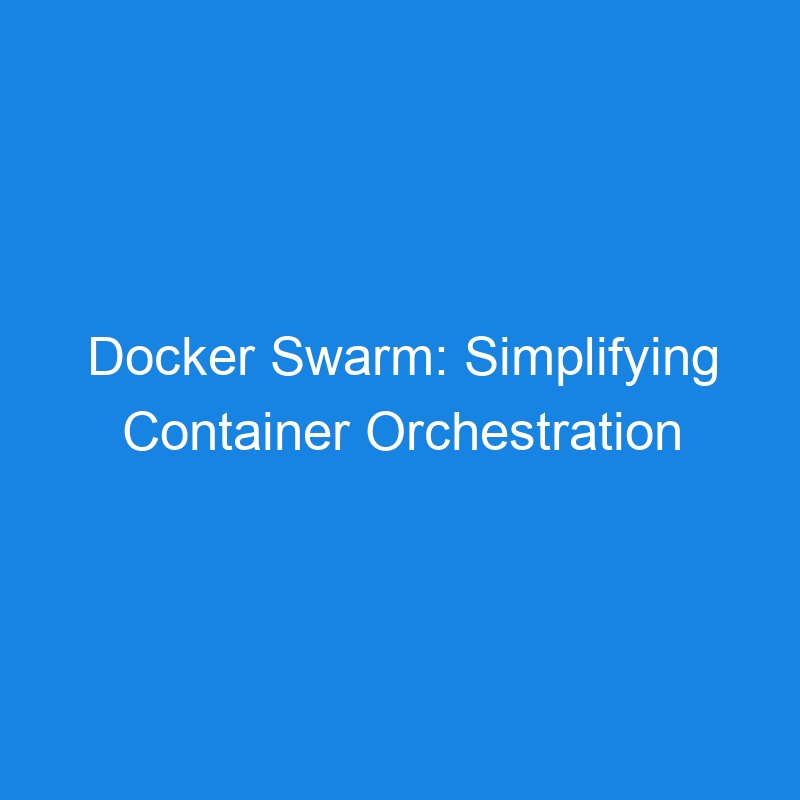Docker Swarm: Orchestrating Containers at Scale
Docker Swarm is Docker’s native container orchestration tool, designed to manage and deploy containerized applications across a cluster of nodes. It transforms a pool of Docker hosts into a single, virtual host, making it easier to scale, deploy, and manage services in a distributed environment.
Key Features of Docker Swarm
- Clustering: Combines multiple Docker nodes into a cluster to increase scalability and fault tolerance.
- Decentralized Design: Built-in leader election ensures high availability.
- Service Scaling: Easily scale services up or down by adjusting the number of replicas.
- Load Balancing: Automatically distributes traffic across available nodes and containers.
- Rolling Updates: Deploy updates to services incrementally to avoid downtime.
- Security: Includes TLS encryption, mutual authentication, and certificate rotation.
- Ease of Use: Integrated with Docker CLI, making it simple for developers familiar with Docker.
Key Components of Docker Swarm
-
Manager Nodes:
- Orchestrate and manage the cluster.
- Responsible for task scheduling, service deployment, and cluster state management.
- Use Raft Consensus for leader election and state replication.
-
Worker Nodes:
- Execute tasks assigned by the manager.
- Run containers and report back their status to the manager.
-
Services:
- Define how tasks (containers) are executed on the Swarm cluster.
- Can be replicated (multiple instances) or global (one instance per node).
-
Tasks:
- Individual instances of a container, created based on the service definition.
Setting Up Docker Swarm
1. Initialize the Swarm
The first step in setting up a Docker Swarm is initializing it on a manager node:
docker swarm init --advertise-addr <manager_ip>
- The
--advertise-addrflag specifies the manager’s IP address.
2. Add Worker Nodes
After initializing, Docker provides a token to join worker nodes. Run this command on each worker node:
docker swarm join --token <join_token> <manager_ip>:2377
3. Verify the Swarm
On the manager node, check the status of the Swarm:
docker node ls
Deploying a Service in Docker Swarm
To deploy a service, use the docker service create command. For example, to deploy an Nginx service with 3 replicas:
docker service create --name my-nginx --replicas 3 -p 80:80 nginx
Scaling a Service
You can scale a service by adjusting the number of replicas:
docker service scale my-nginx=5
Rolling Updates
To update a service without downtime, deploy a rolling update:
docker service update --image nginx:latest my-nginx
Monitoring the Swarm
- Check Services:
docker service ls
- Inspect Service Details:
docker service inspect my-nginx
- View Tasks for a Service:
docker service ps my-nginx
Advantages of Docker Swarm
- Integrated with Docker CLI: No need to install additional tools or learn new commands.
- Simplicity: Easy setup and management compared to other orchestration tools.
- Lightweight: Less resource-intensive than some alternatives.
- Security: Out-of-the-box encryption and authentication.
Limitations of Docker Swarm
- Less Feature-Rich: Lacks advanced features available in Kubernetes (e.g., custom resource definitions, namespaces).
- Limited Community Support: Kubernetes has a larger ecosystem and community adoption.
- Vendor Lock-In: Swarm is Docker-specific, whereas Kubernetes supports multiple container runtimes.
Docker Swarm vs Kubernetes
| Feature | Docker Swarm | Kubernetes |
|---|---|---|
| Ease of Use | Simple setup and deployment | Steeper learning curve |
| Scaling | Quick scaling | Advanced, fine-grained control |
| Networking | Built-in load balancing | Customizable networking options |
| Community Support | Smaller community | Large, active community |
| Feature Set | Basic orchestration | Comprehensive orchestration features |
When to Use Docker Swarm
- Small to medium-sized projects.
- Teams already familiar with Docker CLI.
- Scenarios where simplicity and ease of setup are priorities.
Conclusion
Docker Swarm provides a simple, efficient way to orchestrate containers at scale, especially for teams already using Docker. While it may not match Kubernetes in features and flexibility, its ease of use and tight integration with Docker make it an excellent choice for smaller deployments or teams new to container orchestration.
